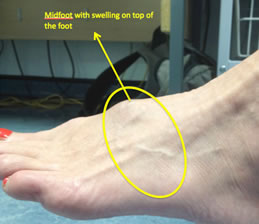in Foot and Ankle Surgery and Reconstruction
A ganglion is a sac filled with a jellylike fluid that originates usually from a tendon sheath or an underlying joint capsule. The word “ganglion” means “knot” and is used to describe the knot-like mass or lump that forms below the surface of the skin.
Women are more likely to get ganglion cysts than men. They most commonly appear in women aged 20-40. You can get ganglions virtually anywhere near a tendon or joint. They are most common around your wrist but can often be seen on the top of the foot, the front of the ankle, or virtually anywhere in the foot or ankle. The don’t have to be “superficial” and easily visible, they can be deeper inside the foot and not easily seen or felt.
It is a benign lump, not a malignant lump or cancer.
Usually the cause is not known. Occasionally they can appear following an injury or repetitive injury to the joint or area.
People usually complain of a lump or swelling often on their foot or ankle, commonly seen on the top of the foot. Wearing shoes can rub on the lump and make them uncomfortable. On occasion the ganglion can be in close proximity to a small nerve. If the nerve gets compressed then patients can complain of numbness or discomfort in the area of skin the nerve supplies. With some ganglions, deeper under the skin for example they can cause a general ache or pain around a joint.

Clinical examination is often enough to diagnose this condition. X-Rays can be taken that may show underlying joint arthritis, but this is not typical. If the diagnosis is uncertain then an ultrasound or MRI scan can be done.
Symptoms from a ganglion are usually tolerated for a long time because the lump can appear and disappear and appear again. It can also gradually enlarge, making shoe-wearing difficult and cause a generalised foot ache.
3 options are possible:
Many patients are simply seeking advice on managing a problem. If the lump is not really causing a large problem then you can leave it alone because they can disappear in some cases. If you have had an aspiration and it recurs then surgery is a good option. The surgery can then be discussed with your surgeon.